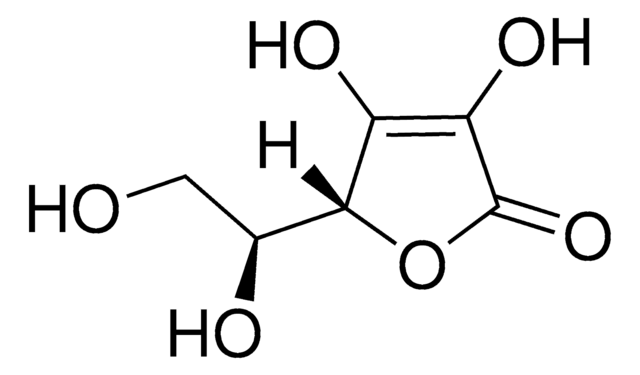31232
Iron(III) chloride hexahydrate
puriss. p.a., reag. Ph. Eur., ≥99%
Synonym(s):
Ferric chloride hexahydrate
About This Item
agency
USP/NF
reag. Ph. Eur.
Quality Level
vapor pressure
1 mmHg ( 194 °C)
grade
puriss. p.a.
assay
≥99%
form
solid
impurities
≤0.001% free chlorine (Cl)
≤0.001% total nitrogen (N)
≤0.05% sub.not precip.b.NH4OH(SO4)
≤0.2% free acid (as HCl)
bp
280-285 °C (lit.)
mp
37 °C (lit.)
anion traces
phosphate (PO43-): ≤100 mg/kg
sulfate (SO42-): ≤50 mg/kg
cation traces
As: ≤5 mg/kg
Cu: ≤20 mg/kg
Fe2+: ≤50 mg/kg
Pb: ≤20 mg/kg
Zn: ≤20 mg/kg
SMILES string
O.O.O.O.O.O.Cl[Fe](Cl)Cl
InChI
1S/3ClH.Fe.6H2O/h3*1H;;6*1H2/q;;;+3;;;;;;/p-3
InChI key
NQXWGWZJXJUMQB-UHFFFAOYSA-K
Looking for similar products? Visit Product Comparison Guide
Related Categories
General description
Application
- Synthesis of 2-substituted 4(3H)-quinazolinones (yield = 77-93%), via condensation of aldehydes with anthranilamide.
- Oxidation of 1,4-dihydropyridines (1,4-DHPs) to corresponding pyridines.
- Oxidation of 4-isopropyl-1,4-DHP to dealkylated pyridine.
signalword
Danger
hcodes
Hazard Classifications
Acute Tox. 4 Oral - Eye Dam. 1 - Skin Irrit. 2
wgk_germany
WGK 1
flash_point_f
Not applicable
flash_point_c
Not applicable
Certificates of Analysis (COA)
Search for Certificates of Analysis (COA) by entering the products Lot/Batch Number. Lot and Batch Numbers can be found on a product’s label following the words ‘Lot’ or ‘Batch’.
Already Own This Product?
Find documentation for the products that you have recently purchased in the Document Library.
Customers Also Viewed
Articles
Professor Randal Lee (University of Houston, USA) discusses design considerations for iron oxide magnetic nanospheres and nanocubes used for biosensing, including synthetic procedures, size, and shape. The effects of these variables are discussed for various volumetric-based and surface-based detection schemes.
Our team of scientists has experience in all areas of research including Life Science, Material Science, Chemical Synthesis, Chromatography, Analytical and many others.
Contact Technical Service



